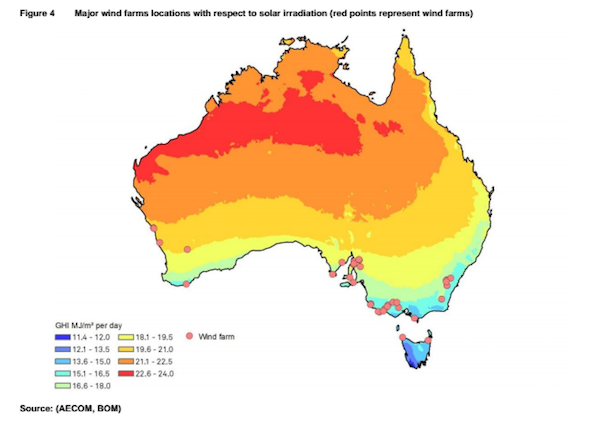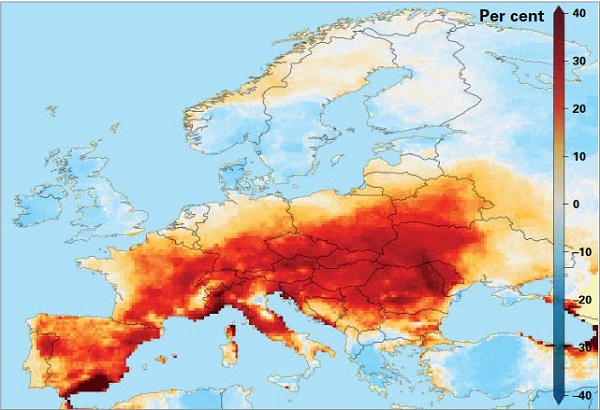1. Hybrid wind and solar farms could deliver significant cost savings
- A total of at least 1GW of large-scale solar could be added to existing Australian wind farms, boosting renewable energy development, generation, and and smoothing its delivery to the grid, according to a new report from the Australian Renewable Energy Agency investigation the benefits of solar and wind “co-location.”
Also:
- The report estimated total cost savings of co-location to be between 3-13 per cent for capital expenditure and 3-16 per cent on operational expenses. On top of this, there was significant potential for a boost to revenues, with more energy being produced at a more consistent rate.
The study looked at 10 existing wind farms and found the best opportunities for adding solar to existing wind were in SA and WA. Here’s a map of wind farm locations against solar potential:

Greeenfield opportunities are also best in SA and WA as well as parts of Queensland and small parts of New South Wales. The 1,200MW Kennedy wind and solar project proposed for north Queensland would be the biggest hybrid of all.
There is also a “firming” effect on intermittency with co-location.
I don’t think I’ve posted this one, but prefab solar could reduce costs fro big solar. For small solar it has the added advantage that you can pack it up and take it with you when you move.
2. Climate change a vote-changer at federal election, says poll
A recent poll found 47% of people agreed or strongly agreed that “climate change and renewable energy will influence the way I vote at this year’s federal election”. Only 22% disagreed with the statement.
- Similarly, 44% of respondents said they either agreed or strongly agreed that measures to protect the Great Barrier Reef would influence their vote – again, more than double the 20% who disagreed.
In all, 65% said they were quite worried, very worried or extremely worried about the impact the Carmichael mine would have on climate change and the Great Barrier Reef. Only 15% said they were not worried at all and 20% were not aware of the plans.
Furthermore:
- The survey also asked respondents what they thought of the statement: “The federal government was right to cut jobs, including those of climate scientists at the CSIRO.” A total of 49% disagreed or strongly disagreed, with only 20% agreeing or strongly agreeing.
3. The world’s lakes are drying
Bolivia’s second-largest lake has dried up and may be gone forever. The Aral Sea, the fourth largest lake in the world, has almost completely dried up. Eight mighty rivers run dry.
The New Scientist says many of world’s lakes are vanishing and some may be gone forever.
The reasons are mainly water extraction, silting and climate change. The water in lakes is warming faster than the surrounding air. Rain patterns are being disturbed. The eastern Mediterranean has just gone through its worst drought in 900 years, for example. In northern Alaska over the last 60 years the surface area of ponds has diminished by nearly a third, and nearly a fifth of the ponds have vanished.
In a few areas, such as the Tibetan Plateau, new ponds are forming and lakes are growing, presumably again because of climate change.
We are losing more than water. Ecologies are changing and fisheries are failing.
4. Hotter, wetter, drier
World Meteorological Day is each year on the date on March 23 to mark the day in 1950 when the treaty creating the World Meteorological Organization came into force.
The WMO’s news site was “under maintenance” when I tried, and their new site didn’t work properly, but WunderBlog has a post. The theme is “Hotter, Drier, Wetter – Face the Future.”
- Human-produced climate change is already hiking the odds of the three weather trends highlighted by the WMO. Heat extremes are on the rise both nationally (see photos below) and globally. In many parts of the world, the heaviest precipitation events (such as the top 1% of one-day totals) are becoming even heavier. And when drought strikes, the impact is exacerbated by a warmer atmosphere, which allows more moisture to escape from parched soils and drying lakes; in turn, the ever-drier ground allows temperatures to soar even further. This year’s World Meteorological Day theme reminds us, as does a recent report from the National Academies, that the climate of our future is related to the weather events that we deal with every day.
Here’s a figure showing the percentage of warm days (exceeding the 90th percentile of the reference period, 1981–2010) relative to
average during European summer 2015:

5. Climate Reality Project
Al Gore’s Climate Reality Project has an Australian presence where Andrew Woodward does a weekly news roundup, with special focus on Australia.
I’ve added a link to the Selected Climate Sites page (see LHS side-bar).
Woodward is a member of the Labor Party and is challenging Tony Abbott in the upcoming election.


I’d personally take that poll with a grain of salt.
Simon Sheikh ( commissioner ) and Chris Lonergan ( conductor ) are old mates with a history of helping each other out.
About as trustable as a Fox News survey commissioned by the NRA.
Well Simon Sheikh is founder and MD of Future Super, Australia’s first fossil free super fund.
But it is possible that they are both interested in the truth.
In case anyone missed this catalyst on 24 hour batteries here is a link.
https://youtu.be/judnHC4wsJs
Yesterdays news had an article on the availability of Lithium. Whereas that is an issue, I did a basic study on this for an exchange of ideas elsewhere and I determined that from a single mine reserve in a US state there was sufficient lithium for every one of nine billion people to have 9 kwhrs of Lithium Ion battery storage. Or for a family of four to have two hybrid electric vehicles and for their house to have 18 kwhrs of storage. In other words there is sufficient for the world to convert substantially to all electric at the personal level.
The renewable wheels are turning as is evident from the Catalyst article. Particularly interesting to me is the interconnected subdivision with a single grid connection. In this case it is being installed for the commercial benefit of the property investor primarily, less benefit for the property occupiers, but its creation sets the precedent for very local solar smart grids (one block large of maybe 40 or 50 houses) with one major grid connection buying and selling power as needed at wholesale rates.
This system can be overlaid with very little effort into existing suburbs with the added benefit of removing a lot of the street power poles which would become redundant.
It is important to have this possibility in mind as people rethink the “Aussie back yard” as the ABC is suggesting. The “new” back fence may need to include a services trench into which to lay the local grid power feed cable, and power boxes may be better at the back of the house rather than the side or front. And should water and sewerage be manage in the same way, eventually?
So what might the Aussie back fence become? I am imagining the each property gives up half a metre of their back yard to create a one metre wide “common right of way” (as distinct from a public right of way) through which the services trench can be placed. The common would be able to be built over above perhaps 2.5 metres leaving sufficient space for the trench to be serviced by contractors.
With such an interconnection properties within a street block will be able to buy and sell solar power and storage capacity with their neighbours for better common advantage. Managing the flow and distribution of this power is an easy task for today’s electronic metering systems with WiFi interconnectivity.
A little more on the at Strata Energy System.
https://youtu.be/RSV1iZuEOxo
This will have implications for tower residential complexes as well.
On a happier note, see what I stumbled over:
http://www.abc.net.au/news/2016-03-30/recyclable-solar-storage-battaries-to-take-on-giants-tesla/7284518
Solar. Recyclable. ?Cheaper??
Red Flow are making some pretty big claims there, Graham. They are claiming 80 watt hours per litre of electrolyte. If it can be substantiated then that is awesome performance. The will guarantee 2000 charging cycles which is ok.
https://en.wikipedia.org/wiki/Zinc%E2%80%93bromine_battery
the Wiki suggests about $400 per kilowatt hour, so perhaps $6000 for a system with an energy recovery rate of 3.5 kw. Not at all bad, so there are an increasing number of options for home storage.
Thanks a lot for that link, BilB. We have come a long way from the old nickel-iron batteries that used to power railway carriage lights.
Brian: What irony if Andrew Woodward displaced Tony Abbott in a “safe” Liberal seat. Not impossible given the widespread concern, among people of all political persuasions, at what is happening to our planet.
That wind-solar opportunities map might be showing the way to economic security and to much improved lifestyle for remote area communities.